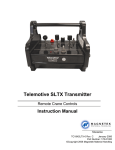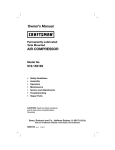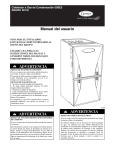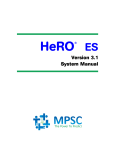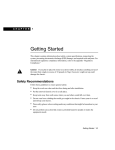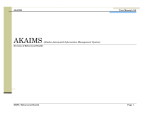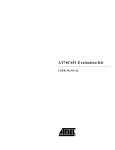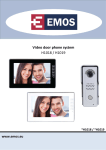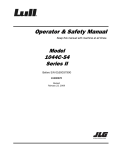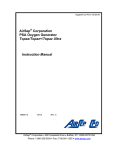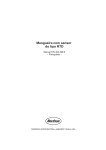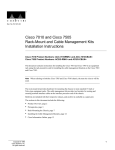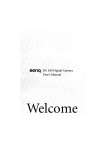Download C11440-22CU C14400-22CU01 Instruction manual
Transcript
ORCA-Flash4.0 V2 Digital CMOS Camera C11440-22CU/C11440-22CU01 Instruction manual Thank you for your purchase • Follow the safety precautions in Chapter 1 in order to avoid personal injury and damage to property when using this camera. Be sure to read this Instruction manual beforehand in order to use the digital camera correctly. The manual describes the correct method of handing the camera and provides cautions in order to avoid accidents. • After reading, keep the manual where it can be referred to at any time. Ver.1.5 Sep 2015 HAMAMATSU PHOTONICS K.K. 95900306-05 ~ Blank page ~ C11440-22CU/C11440-22CU01 Instruction manual_Ver.1.5 1. SAFETY PRECAUTIONS 1-1 INDICATION OF THE SYMBOLS The following symbols can be found on this camera: Direct current Alternating current 1-2 CLASSIFICATION OF WARNING We have classified the warnings symbols that appear in this instruction manual and on the camera as follows for your convenience. Make sure that you fully understand them and obey the instructions they contain. Improper handling of the camera without observing these warnings could lead to serious injury to the user and even death. Improper handling of the camera without observing these cautions could lead to personal injury to the user or damage to property. Note This symbol indicates a note to help you get the best performance from the camera. Read the contents of the note carefully to ensure correct and safe use. Failure to observe one of these notes might impair the performance of the camera. This symbol indicates a cautionary item that should be obeyed when handling the camera. Read the contents carefully to ensure correct and safe use. This symbol indicates an action that is forbidden. Read the contents carefully and be sure to obey them. This symbol indicates a compulsory action or instruction. Read the contents carefully and be sure to obey them. 1 C11440-22CU/C11440-22CU01 Instruction manual_Ver.1.5 Power supply Use the camera with the voltage indicated on the rating sticker. Using a different voltage can damage the camera and lead to fire or electric shock. Cables Be careful not to place heavy objects on cables or bend it excessively. Doing so can damage the cable and lead to fire or electric shock. Power supply cord Use the accessory of the AC adapter when this camera is used. Do not touch the plug with wet hand. Doing so can lead to electric shock. Do not attempt to dismantle or modify the camera Doing so can also lead to damage and even injury, as some internal components become very hot. Only touch parts as indicated in this manual. Do not insert a foreign substance into the camera Do not allow foreign objects such as combustible substances, metal objects or water to get inside the camera. They can damage the camera and lead to fire or electric shock. If an abnormality occurs Such as the image suddenly disappearing or a strange noise, smell or see smoke coming from the camera, stop the power supply immediately and contact Hamamatsu subsidiary or local distributor. Never attempt to repair the camera yourself. 2 C11440-22CU/C11440-22CU01 Instruction manual_Ver.1.5 AC adapter When unplugging the AC adapter, always pull by the plug, but remove the plug from the outlet to avoid causing electric shock or fire. When the system is not used for a long period of time, unplug the power supply cord from the outlet to avoid damaging the cord and causing electric shock or fire. Connecting and disconnecting cables Always turn off the power supply of the peripheral device before connecting and disconnecting cables. Fixed the camera When fitting the camera to a tripod or other fixture, use the optional base plate. Be careful that the fitting screw does not enter more than 8 mm from the surface of the base plate. Screwing it in excessively can impair normal operation. Lenses (C11440-22CU) Be careful not to screw the lens more than 7 mm onto the C-mount of the camera. Doing so can scratch the protective glass. (Some wide-angle lenses in particular can have a thread of 7 mm or more.) Shipping precautions When transporting the camera by truck, ship, airplane, etc., wrap it securely in packaging material or something similar. Strong impact Do not subject the camera to strong shocks by dropping it, for example. Doing so can damage the camera. At the water cooling Be careful water does not splash on the camera. Cut off the power supply of the circulating water cooler and the camera when you remove and install the cooling water hoses. Operating environment This system is designed and tested for use in an industrial environment. If this system is used in residential areas, EMI (electro-magnetic interference) may occur. This system must not be used in residential areas. 3 C11440-22CU/C11440-22CU01 Instruction manual_Ver.1.5 Disposal When disposing of the camera, take appropriate measures in compliance with applicable regulations regarding waste disposal and correctly dispose of it yourself, or entrust disposal to a licensed industrial waste disposal company. In any case, be sure to comply with the regulations in your country, state, region or province to ensure the camera is disposed of legally and correctly. Cooling water It is recommended to use soft water (except deionized water) for cooling water. Follow instruction manual which is attached to your circulating water cooler for an appropriate temperature range of cooling water. If you plan on using water other than soft water as recommended for example antifreeze etc, please refer to description of cooling water which is written in 12. [Maintenance] or contact Hamamatsu subsidiary or local distributor. Condensation At the Water-cooling, if ambient temperature and ambient humidity become high, condensation will take place easily. Use the camera under the environment where condensation will not take place referring to the following graph. 4 C11440-22CU/C11440-22CU01 Instruction manual_Ver.1.5 2. CHECK THE CONTENTS OF PACKAGE When you open the package, check that the following items are included before use. If the contents are incorrect, insufficient or damaged in any way, contact your local dealer without attempting to operate the camera. Camera: C11440-22CU or C11440-22CU01 1 AC adapter 1 Power supply cord for AC adapter 1 Lens mount cap 1 (attached to the camera) C11440-22CU/C11440-22CU01 Before Use (Booklet) 1 C11440-22CU/C11440-22CU01 Instruction manual (CD-ROM) 1 QC sheet 1 [Option] Cooling water hose (2 hoses) SMA-BNC cable SMA-SMA cable Camera Link interface cable USB 3.0 interface cable USB 3.0 interface board Adjuster pole for C11440-22C Base plate for C11440-22C Camera Link interface board Note Note Note A10788-04 A12106-05 A12107-05 A11255-05 A12467-03 M9982-21 A11185-01 A11186-01 M9982-20 • The cable listed in option is highly recommended for use with the camera. The camera system may not confirm to CE marking regulation if other type of cable is used with. • The cooling is set as air cooling at factory setting. It is possible to change the cooling setting from Air cooling to Water cooling by the special software included. • Handle the circulating water cooler and the cooling water according to an instruction manual of the circulating water cooler. • If you use the adjuster pole and the base plate, see each installation manual. 5 C11440-22CU/C11440-22CU01 Instruction manual_Ver.1.5 3. INSTALLATION Avoid using or storing this camera in the following places • • • • • • • • • When the ambient temperature for using this system might fall below 0 °C or rise above +40 °C. When the ambient temperature for storing this system might fall below -10 °C or rise above +50 °C. Where the temperature varies extremely. In direct sunlight or near a heater. Where the humidity is 70 % or more or where there is dripping water. Close to a strong source of magnetism or ratio waves. Where there is vibration. Where it might come into contact with corrosive gases (such as chlorine or fluorine). Where there is a lot of dust. How to place the camera (when the camera is placed on a table) Place the camera the water connectors to be lateral side. Do not place the camera the rear panel of the camera, which connectors are located, to be at the bottom. (Do not block ventilation openings.) Do not block ventilation openings To prevent overheating in the camera’s interior, do not wrap the camera in cloth or other material, or in any way allow the camera’s ventilation ports to become blocked. If the camera is being operated in an enclosed environment, ensure clearance of at least 2 cm from both the intake and exhaust vents when setting up. Weight of the camera Be careful not to drop off the camera or not drop underfoot when making it move because it is approx. 2 kg. 6 C11440-22CU/C11440-22CU01 Instruction manual_Ver.1.5 Contents 1. SAFETY PRECAUTIONS ............................................................................ 1 1-1 1-2 INDICATION OF THE SYMBOLS .........................................................................1 CLASSIFICATION OF WARNING ........................................................................1 2. CHECK THE CONTENTS OF PACKAGE ................................................... 5 3. INSTALLATION ........................................................................................... 6 4. OVERVIEW .................................................................................................. 9 5. FEATURES .................................................................................................. 9 6. NAME AND FUNCTION OF THE PARTS ................................................. 12 7. CONNECTION ........................................................................................... 15 8. WATER COOLING .................................................................................... 18 8-1 8-2 8-3 CAUTIONS ...........................................................................................................18 CONNECTION OF WATER COOLING HOSES .................................................20 DISCONNECTION OF WATER COOLING HOSES ...........................................21 9. OPERATION .............................................................................................. 22 9-1 9-2 PRECAUTIONS ...................................................................................................22 PREPARATION FOR IMAGING..........................................................................23 9-3 END OF IMAGING ...............................................................................................23 9-2-1 9-2-2 WHEN USING AIR-COOLING ......................................................................................... 23 WHEN USING WATER-COOLING ................................................................................... 23 10. DESCRIPTION OF VARIOUS FUNCTIONS ............................................. 24 10-1 THEORY OF CMOS IMAGE SENSOR ...............................................................24 10-2 NORMAL AREA MODE.......................................................................................26 10-2-1 10-2-2 10-2-3 10-2-4 10-2-5 10-2-6 10-2-7 10-2-8 READOUT METHOD (SCAN MODE) ............................................................................... 26 FRAME RATE CALCULATION......................................................................................... 27 CONFIGURING EXPOSURE TIME .................................................................................. 31 FREE RUNNING MODE .................................................................................................. 32 EXTERNAL TRIGGER MODE ......................................................................................... 34 TRIGGER OUTPUT ........................................................................................................ 39 SLOW SCAN .................................................................................................................. 41 GLOBAL RESET ............................................................................................................. 42 10-3-1 10-3-2 10-3-3 10-3-4 10-3-5 READ-OUT DIRECTION ................................................................................................. 44 FRAME RATE CALCULATION......................................................................................... 45 READ-OUT TIME OF THE HORIZONTAL LINE................................................................ 45 TIMING DIAGRAM .......................................................................................................... 46 PROGRAMMABLE TIMING OUTPUT .............................................................................. 48 10-3 LIGHT SHEET MODE ..........................................................................................44 10-4 REAL-TIME CORRECTION FUNCTIONS ..........................................................49 11. PRECAUTION WHEN USING CMOS IMAGE SENSOR ........................... 50 12. MAINTENANCE......................................................................................... 51 12-1 CARE ...................................................................................................................51 7 C11440-22CU/C11440-22CU01 Instruction manual_Ver.1.5 12-2 INFORMATION ON COOLING WATER FOR THE CIRCULATING WATER COOLER ..............................................................................................................52 12-2-1 WHEN USING COOLING WATER OTHER THAN RECOMMENDED ................................ 52 13. TROUBLESHOOTING CHECKLIST ......................................................... 53 13-1 IMAGE IS NOT TRANSFERRED ........................................................................53 13-2 ALTHOUGH IMAGES ARE TRANSFFERED .....................................................53 14. SPECIFICATIONS ..................................................................................... 54 14-1 14-2 14-3 14-4 CAMERA SPECIFICATIONS ..............................................................................54 CONDENSATION ................................................................................................57 SPECTRAL RESPONSE CHARACTERISTICS(TYP.) ......................................58 INTERFACE SPECIFICATIONS .........................................................................59 14-4-1 CAMERA LINK INTERFACE ............................................................................................ 59 14-4-2 OUTPUT TIMING SPECIFICATIONS ............................................................................... 62 15. DIMENSIONAL OUTLINES ....................................................................... 66 15-1 C11440-22CU ......................................................................................................66 15-2 C11440-22CU01 ..................................................................................................67 16. WARRANTY .............................................................................................. 68 17. CONTACT INFORMATION ....................................................................... 69 8 C11440-22CU/C11440-22CU01 Instruction manual_Ver.1.5 4. OVERVIEW C11440-22CU/C11440-22CU01 is equipped with the new scientific image sensor, an advanced CMOS device that realizes the multiple benefits of high resolution, high readout speed, and low noise all at once. The camera provides 4.0 megapixels resolution at 100 frame/s (and up to 25 655 frame/s by sub-array readout) while achieving 1.0 electrons (median) 1.6 electrons (r.m.s) readout noise performance. Moreover, the camera delivers high sensitivity through its on-chip micro lens, 37 000:1 high dynamic range that make the camera suitable for almost any scientific application from bright field imaging to low-light fluorescence imaging across a wide spectral range. Various external trigger functions and timing output functions ensure proper timing control with peripheral equipment to cover a wide range of applications. The camera is the new scientific digital camera for life science microscopy, semiconductor inspection, x-ray scintillator readout or industrial imaging. 5. FEATURES (1) Readout noise In the camera, the pixel amplifier is optimized: it has high gain from optimizing the semiconductor process, and the difference among pixel amplifiers are greatly minimized. In addition, there is on-chip CDS (correlated double sampling) circuit, which plays an important role in achieving low noise. Moreover, the sensor features a split readout scheme in which the top and bottom halves of the sensor are readout independently, and the data of each horizontal line is read by 2 lines of column amplifier and A/D in the top and the bottom in parallel and simultaneously. As a result, it achieves very fast readout speed while keeping very good low-noise performance. The camera has lower readout noise (1.0 electrons (median), 1.6 electrons (r.m.s)) than the conventional cooled CCD camera. Moreover, high-speed readout (100 frame/s with 2048 pixels × 2048 pixels) with very low readout noise, which was impossible, can now be achieved. (2) Cooling structure In the camera, CMOS image sensor is cooled down by the peltier element to suppress the dark current. If CMOS image sensor is exposed to the atmosphere, condensation of the moisture from the air might occur. However the camera has a special hermetic chamber structure to isolate the sensor from the atmosphere, and the chamber is filled with nitrogen gas. (3) Pixel number and pixel size CMOS image sensor has 6.5 µm x 6.5 µm pixel sizes that is equivalent to conventional CCD image sensor (2/3 inch, 1.3 megapixels). Also, the camera can observe a wider field of view because the pixel number is about 3 times that of the conventional CCD image sensor (2/3 inch, 1.3 megapixels) (4) Readout method The camera has a variety of readout modes. In addition to full resolution readout mode, sub-array readout and binning readout are supported. 9 C11440-22CU/C11440-22CU01 Instruction manual_Ver.1.5 (5) Frame rate (readout speed) CMOS image sensor which this camera adopts realizes both low noise (1.0 electrons (median) 1.6 electrons (r.m.s)) and high speed readout (100 frame/s with 2048 pixels x 2048 pixels) simultaneously, by a split readout scheme in which the top and the bottom halves of the sensor are readout independently, and the data of each horizontal line is read by 2 lines of column amplifier and A/D in the top and the bottom in parallel and simultaneously. (6) Real-time correction functions When using the camera, there is a case that shading caused by uneven illumination or optics is not negligible in the image. Also, there are a few pixels in CMOS image sensor that have slightly higher readout noise performance compared to surrounding pixels. For those cases, the camera has real-time offset level, shading and defective pixel correction features to further improve image quality. The correction is performed in real-time without sacrificing the readout speed at all. (7) Interface This camera has both Camera Link and USB 3.0 interface. ■ Camera Link Interface Camera Link interface is able to transfer large volumes of data. It can transfer 4 megapixels image with 100 frame/s. In order to realize such large volume data transfer, the camera uses Camera Link "Full Configuration Deca Mode" which is an expanded version of Camera Link "Full Configuration". It enables to transfer maximum 85 MHz x 10 Taps (8 bit) image data to computer as fast as 100 frame/s. In order to use this interface, a Camera Link interface board which supports "Full Configuration Deca Mode" is required. ■ USB 3.0 Interface USB 3.0 interface is able to transfer 4 megapixels image with 30 frame/s. It is versatile interface which is suitable to use when fast data transfer is not required. This interface does not require a Camera Link interface board. It transfers image with moderate transfer speed. • Do not connect Camera Link and USB 3.0 interface simultaneously. • When a connection interface is changed from Camera Link to USB 3.0, and vice versa, the application software must be closed and the camera must be turned off. (8) Camera readout modes The camera has two scan speed in Normal area mode, and two readout direction in Light sheet mode. 10 C11440-22CU/C11440-22CU01 Instruction manual_Ver.1.5 (9) Camera operation modes The camera has three operation modes: 1) the free running mode, in which the exposure and readout timing are controlled by the internal microprocessor, and 2) the external trigger mode, in which the exposure and readout timing are decided by an external trigger. 3) the start trigger mode is used to start operating the camera by a trigger input for a continuous imaging. 11 C11440-22CU/C11440-22CU01 Instruction manual_Ver.1.5 6. NAME AND FUNCTION OF THE PARTS (1) C11440-22CU ② ① ④ ③ ⑤⑥ ⑪ ⑦⑧ ⑨ ⑩ ⑫ (2) C11440-22CU01 ② ① ④ ③ ⑤⑥ ⑪ ⑦⑧ ⑨ ⑩ ⑫ 12 C11440-22CU/C11440-22CU01 Instruction manual_Ver.1.5 • Place the camera the water connectors to be lateral side. Do not place the rear panel of the camera, which connectors are located, to be at the bottom (Do not block ventilation openings.). ① Lens mount C11440-22CU can be attached to C-mount lens or an optics system. C11440-22CU01 can be attached to F-mount lens or an optics system. Note • The depth of the C-mount is 7 mm. can scratch the glass surface. Screwing in the mount too far ② WATER connector [WATER] (at Water-cooling) It connects the camera and the circulating water cooler with the cooling water hoses. The insert position of WATER IN/OUT is not specified. Please see 8. [Water cooling] for details. • ③ Camera Link interface connector [DIGITAL OUT 1] This is connected to the Camera Link interface connector 1 on the computer. ④ Camera Link interface connector [DIGITAL OUT 2] This is connected to the Camera Link interface connector 2 on the computer. ⑤ Trigger input connector [EXT.TRIG] This is used when the camera is being operated using external synchronization. Input is 3.3 V LVCMOS level, and input impedance is 10 kΩ. When an external trigger is input, the trigger is activated at the falling or rising edge of the signal. (You can choose external trigger polarity between Negative and Positive.) ⑥ Timing out connector 1,2,3 [TIMING 1,2,3] This is used when peripheral device(s) require synchronization with the camera. Output is 3.3 V LVCMOS level, and it is output though BUS TRANSCEIVER IC SN74AVC8T245. Output impedance is 33 Ω. Note • Determine termination according to cable length and so on. ⑦ STATUS lamp [STATUS] The LED indicates status of camera. Lighting color Status of power distribution Turn off (no color) Green (Blinking) Green (lighting) Power off Initialization Power on Orange (lighting) Data transfer Red Heat up (lighting) • When the camera heats up, stop operation and unplug the AC adapter immediately. 13 C11440-22CU/C11440-22CU01 Instruction manual_Ver.1.5 ⑧ Power switch [POWER] The power is turned on/off. When the power switch is set to "ON", the camera turns on and starts initialization and the lamp blinks in green. When the initialization is completed , the lamp color stays in green. When the camera transfers data and the lamp color is orange. When the power switch is set to "OFF", the camera returns to the power off state and the lamp turns off. ⑨ DC power input connector [DC IN] This is the power supply terminal. Use the accessory AC adapter. ⑩ USB 3.0 interface connector [USB 3.0] This is connected to the USB 3.0 interface connector on the computer. • Do not connect Camera Link and USB 3.0 interface simultaneously. • When a connection interface is changed from Camera Link to USB 3.0, and vice versa, the application software must be closed and the camera must be turned off. ⑪ Air inlet This is the inlet for the heat ventilation. • To prevent overheating inside the camera, do not wrap the camera in cloth or other material, or block the camera’s ventilation. • If the camera is being operated in an enclosed environment, ensure to keep clearance at least 2 cm from both intake and exhaust vents when setting up. ⑫ Screw holes for attaching the option They are used for attaching an adjuster pole(A11185-01) or a base plate(A1186-01). A11185-01 and A11186-01 are the options of C11440-22C. • 14 Refer to each manual about the attaching method of the option. C11440-22CU/C11440-22CU01 Instruction manual_Ver.1.5 7. CONNECTION Note • When you connect cables, turn off the power supply of the camera and the peripheral devices. • If you use the adjuster pole and the base plate, see each installation manual. • Place the camera the water connectors to be lateral side. Do not place the rear panel of the camera, which connectors are located, to be at the bottom (Do not block ventilation openings.). Refer to the figure when connecting the various cables. Overall connection Camera (Rear) ② Cooling water hose (2 hoses) ① AC adaptor Interface cable Computer Interface board Circulating water cooler Figure 7-1 15 C11440-22CU/C11440-22CU01 Instruction manual_Ver.1.5 ■ Connection to Camera Link ■ Connection to USB 3.0 Camera (Rear) ① AC adaptor ③ Camera Link interface cable 1 Camera (Rear) AC adaptor ① ④ Camera Link interface cable 2 ⑤ USB 3.0 interface cable Computer Computer Camera Link interface board USB 3.0 interface board To connector 2 To connector 1 Figure 7-2 Figure 7-3 • Do not connect Camera Link and USB 3.0 interface simultaneously. • When a connection interface is changed from Camera Link to USB 3.0, and vice versa, the application software must be closed and the camera must be turned off. ① AC adapter This is the cord to supply a power supply. Use the accessory AC adapter. ② Cooling water hose (at Water-cooling: Option) It connects the camera and circulating water cooler. The insert position of WATER IN/OUT on the camera WATER connector is not specified. • 16 Please see 8. [Water cooling] for details. C11440-22CU/C11440-22CU01 Instruction manual_Ver.1.5 ③ Camera Link interface cable 1 (Option) This is the cable to connect the Camera Link interface connector 1 of the camera and the Camera Link interface connector 1 on the computer. ④ Camera Link interface cable 2 (Option) This is the cable to connect the Camera Link interface connector 2 of the camera and the Camera Link interface connector 2 on the computer. Note • Hamamatsu recommends A11255-05 optional Camera Link interface cable for this camera. The camera complies with EMC direction with using A11255-05 Camera Link interface cable. Be careful that the camera with other interface cable may not fulfill the EMC directive requirements. ⑤ USB 3.0 interface cable (Option) This is the cable to connect the USB 3.0 interface connector of the camera and the USB 3.0 interface connector on the computer. Note • Hamamatsu recommends A12467-03 optional USB 3.0 interface cable for this camera. The camera complies with EMC direction with using A12467-03 Camera Link interface cable. Be careful that the camera with other interface cable may not fulfill the EMC directive requirements. 17 C11440-22CU/C11440-22CU01 Instruction manual_Ver.1.5 8. WATER COOLING • 8-1 Improper handling of the camera without observing these cautions could lead to personal injury to the user or damage to property. CAUTIONS (1) Cooling water It is recommended to use soft water (except deionized water) for cooling water. If you plan on using water other than soft water as recommended for example antifreeze etc, please refer to description of cooling water which is written in 12. [Maintenance] or contact Hamamatsu subsidiary or local distributor. (2) Recommendation ambient temperature Hamamatsu recommends 20 °C for Circulating water temperature. For the appropriate temperature range of the cooling water, confirm with the instruction manual of your circulating water cooler. (3) Condensation Use the camera under the environment where condensation will not take place referring to the following graph. 18 C11440-22CU/C11440-22CU01 Instruction manual_Ver.1.5 (4) Handling of the circulating water cooler Handle the circulating water cooler and the cooling water according to an instruction manual of the circulating water cooler. Proper performance may not be achievable if a non-recommended circulating water cooler is used. (5) Start water cooling and water cooping in operation • Confirm the water is flowing before starting the camera cooling and that the camera does cool. • Keep 1.0 L/min flow rate for water circulation. • Do not stop coolant while the camera is working. (6) Cooling water hose The hose has a blue hose (Internal diameter: 4 mm / External diameter: 6 mm) and a gray hose (Internal diameter: 8 mm / External diameter: 13.5 mm). (Figure 8-1) If the hose size on circulating water cooler is the same as blue hose, remove gray hose from the joint part. The gray hose can be removed when blue hose is pulled with pushing the button of the joint on gray hose. (Figure 8-2) Gray hose Joint Button Blue hose Figure 8-1 Figure 8-2 (7) Connection of the cooling water hose • Follow the instruction in Section 8-2 [CONNECTION OF WATER COOLING HOSES] and Section 8-3 [DISCONNECTION OF WATER COOLING HOSES] to connect / disconnect the hose. • Stop water circulation when connecting / disconnecting the hose, and turn off the power of the camera and the circulating water cooler. • Confirm that cooling water stops. • Prepare water absorption sheet (such as Waste, Towel or so) and catch pan in order to avoid water drop or water splash. (8) Deterioration of the cooling water hose Replace the water hose with a new one whenever it cannot keep the Keep 1.0 L/min flow rate for water circulation due to the hose deterioration. 19 C11440-22CU/C11440-22CU01 Instruction manual_Ver.1.5 8-2 CONNECTION OF WATER COOLING HOSES Water cooling hose WATER connector Figure 8-3 (1) Place the camera on the stable table. (2) Connect water cooling hose into the WATER connector on the camera. • Insert the hose fully into the WATER connector on the camera. (as shown in Figure 8-3) • Confirm the hose stops at it. (3) Set the camera onto a microscope (If the camera is used on the microscope). If it is easy to connect the hose onto the camera after the camera is set onto the microscope then it is OK to connect the hose after the camera is set on the microscope. (4) Connect the hose onto the circulating water cooler. Follow the instruction on the circulating water cooler when you connect the hose onto the circulating water cooler. (5) Turn on the circulating water cooler and confirm the cooling water is flowing normally. • 20 Stop the circulating water cooler when the water flow is abnormal or water drop or splash is found. C11440-22CU/C11440-22CU01 Instruction manual_Ver.1.5 8-3 DISCONNECTION OF WATER COOLING HOSES • Remove the water cooling hoses only when it is necessary to remove. (1) Turn off the camera power and all peripheral devices including circulating water cooler. (2) Remove the hose on circulating water cooler side. Follow the instruction on the circulating water cooler when you disconnect the hose from the circulating water cooler. (3) Remove water or water drop inside the hose and the camera by air. • Blow Air from one side of hose. Prepare water absorption sheet (such as Waste, Towel or so) and catch pan on another side of hose in order to avoid water drop or water splash. • Blow Air until no water drop come out. (4) Remove the camera from the microscope (if the camera is used on the microscope). It is not necessary to remove the camera from the microscope if it is possible to remove the hoses from the camera as it is. (5) Place the camera on the stable table. Put the lens cap on to protect the sensor. (6) Change the WATER connector direction to be downward. Prepare water absorption sheet (such as Waste, Towel or so) and catch pan. (7) Remove hoses one by one, and wipe water. Disconnect hoses with pushing button while being careful not to splash water. Button Figure 8-4 • Cooling water may be left inside the camera even after hoses are removed. In such case, remove water inside by blowing air from connectors. Be careful not to splash water onto the camera. 21 C11440-22CU/C11440-22CU01 Instruction manual_Ver.1.5 9. OPERATION 9-1 PRECAUTIONS Be careful of the following when you operate the camera. (1) Cooling method Cooling of this equipment is done using a Peltier element. With a Peltier element, when current is supplied, one surface is cooled, and the other surface is heated. CMOS image sensor is positioned on the cooled side, and cooling is done by discharging the heat from the heated surface. The camera has two cooling modes, Air-cooling mode and Water-cooling mode. Cooling mode can be changed by software which is called, “DCAM Configurator”. After cooling mode was changed, the camera memorizes the last setting as the default setting for cooling. The present cooling mode set-up of this camera can be checked using “DCAM Configurator”. Note • A software “DCAM Configurator " is in a CD-ROM of DCAM software. Cooling method Detail Air-cooling mode (Forced air-cooled) (Default) The heated side of a peltier element is cooled by a fan inside the camera. When the camera is turned on, the fan starts rotating and cooling is started. Circulating water cooler (Optional) is used for cooling the heated side of a peltier element. Cooling does not start just turning on the camera. Cooling water circulation must be started before start operating the camera in water-cooling. A fan inside the camera does not rotate. (Please refer to 8 [WATER COOLING] for instruction of water-cooling.) Water-cooling mode • Do not switch to water-cooling mode when water-cooling is unnecessary. (2) Ambient temperature The recommended ambient temperature for camera operation is 20 °C. Both water-cooling or air-cooling are available as cooling method, CMOS image sensor cooling temperature is more stable under water cooling operation. (3) Protection circuit A double protection circuit protects this camera’s thermoelectric cooling device. If the heat dissipater becomes abnormally hot, the protection circuit sets off a buzzer alarm and stopping current supply to Peltier element simultaneously. When the protection circuit is activated immediately turn off the power switch. Then investigate cause and remove the cause of the overheating and restart the camera. 22 C11440-22CU/C11440-22CU01 Instruction manual_Ver.1.5 9-2 PREPARATION FOR IMAGING Use the following procedure when start operating the camera. 9-2-1 • When you connect cables, turn off the power supply of the camera and the peripheral devices. • Please change cooling method (cooling mode) if needed. The present cooling mode set-up of this camera can be checked using DCAM Configurator. WHEN USING AIR-COOLING (1) Connect the equipment as shown in Figure 7-1 before operating of the camera. (2) Turn on the camera. (3) Check cooling fan is operating properly and air is circulating. 9-2-2 WHEN USING WATER-COOLING (1) (2) (3) (4) (5) Connect the equipment as shown in Figure 7-1 before operating of the camera. Turn on the camera. Turn on the circulating water cooler. Check cooling water is circulating suitably. Turn on the cooling switch of the camera from application software. Note 9-3 • Please refer to the manual of application software for ON/OFF of the cooling switch of a camera. END OF IMAGING Follow the procedure below when imaging is finished. (1) End the imaging or transmission of image data with the application software. (2) Turn off the circulating water cooler. (In the case of water-cooling) (3) Turn off the camera and peripheral devices. 23 C11440-22CU/C11440-22CU01 Instruction manual_Ver.1.5 10. DESCRIPTION OF VARIOUS FUNCTIONS 10-1 THEORY OF CMOS IMAGE SENSOR The pixel of a CMOS image sensor is composed of the photodiode and the amplifier that converts the charge into voltage. Entered light is converted to charge and converted to voltage in the pixel. The voltage of each pixel is output by switching the switch one by one. (Figure 10-1) The scientific CMOS image sensor used in this camera has an on-chip CDS (correlated double sampling) circuit, which plays an important role in achieving low noise. In addition, CMOS image sensor realizes both low noise and high speed readout simultaneously, by a split readout scheme in which the top and the bottom halves of the sensor are readout independently, and the data of each horizontal line is read by 2 lines of column amplifier and A/D in the top and the bottom in parallel and simultaneously. Figure 10-1 Structure of CMOS image sensor 24 C11440-22CU/C11440-22CU01 Instruction manual_Ver.1.5 The exposure and the readout method of CMOS image sensor which this camera adopts is rolling shutter. In the rolling shutter, the exposure and readout are done line by line. Therefore, the exposure timing is different on one screen. (Figure 10-2) But even if the object moves during the exposure, the affect of rolling shutter is very small. Figure 10-2 Readout timing of Rolling shutter 25 C11440-22CU/C11440-22CU01 Instruction manual_Ver.1.5 10-2 NORMAL AREA MODE 10-2-1 READOUT METHOD (SCAN MODE) (1) Readout direction The camera readout the image sensor from the center line to the top and from the center line to the bottom simultaneously (center line is depicted in red line in the diagram). Figure 10-3 Normal area mode readout direction (2) Normal readout Perform charge readout from camera individually for all pixels. (3) Binning readout With this camera, 2×2 binning readout and 4×4 binning are available by adding the signal of adjacent pixels in the digital domain, Binning readout is a method for achieving high sensitivity in exchange for losing resolution. (4) Sub-array readout Sub-array readout is a procedure only a region of interest is scanned. It is possible to increase the frame rate by reducing the number of vertical lines scanned. When a target area is placed in the center of the screen, sub-array readout can perform the fastest readout. In sub-array readout, binning configuration is enabled. Size and a position of the readout area can be configured according to the table below. Binning Camera Link Regardless of binning ― ― 1×1 (Normal readout) 512 pixels 32 pixels 8 lines 4 lines 2×2 binning readout 256 pixels 16 pixels 4 lines 2 lines 4×4 binning readout 128 pixels 8 pixels 2 lines 1 lines USB 3.0 Note 26 Settings Horizontal Vertical Size Position Size Position Interface • 4 lines steps Please refer to 10-2-22-2 [FRAME RATE CALCULATION] about the frame rate of each readout mode. C11440-22CU/C11440-22CU01 Instruction manual_Ver.1.5 10-2-2 FRAME RATE CALCULATION 10-2-2-1 At Standard Scan (1) Camera Link Vn = Number of vertical line (The center of the set area is the middle of the sensor.) Exp1 = 1.004 ms to 10 s 1H = 9.74436 × 10-6 • The Exp1 value must be input to the calculation formula below in units of seconds. [Calculation formula, Value of Frame rate ] Calculation formula Free running mode 1/(Vn/2×1H) External trigger mode (Edge trigger / Level trigger) 1/(Vn/2×1H+Exp1+1H×10) External trigger mode (Synchronous trigger readout) 1/(Vn/2×1H+1H×18) External trigger mode (Fast Synchronous trigger readout) 1/(Vn/2×1H+1H×5) Horizontal Vertical 2048 2048 1024 512 256 128 64 8 2048 2048 1024 512 256 128 64 8 2048 2048 1024 512 256 128 64 8 2048 2048 1024 512 256 128 64 8 Frame rate (frame/s) 100 200 400 801 1603 3206 25 655 90 164 278 425 579 707 876 98 193 374 702 1251 2052 4664 99 198 393 771 1487 2773 11 402 27 C11440-22CU/C11440-22CU01 Instruction manual_Ver.1.5 (2) USB 3.0 Vn Exp1 Exp2 1H int () = = = = = Number of vertical line (The center of the set area is the middle of the sensor.) 1.004 ms to 10 s 1.05 ms to 10 s -6 9.74436 × 10 The decimal point is rounded down. • The Exp1 and Exp2 values must be input to the calculation formula below in units of seconds. [Calculation formula] Binning Free running mode 1×1 2×2 ― ― ― ― 4×4 1×1 1×1 External trigger mode (Level trigger) 112≦Vn≦2048 2×2 ― ― 4×4 ― 1024 1536 2048 1024 1536 2048 ― 112≦Vn≦2048 512 ― 2×2 ― ― ― ― 1×1 1×1 1/ (int(Vn/2048/100/1H)×1H) 1/ (int(Vn/2048/30/1H)×1H) 1/ (Vn/2×1H+1H×10+Exp1) 1/ (int(Vn/2048/30/1H)×1H) 8≦Vn≦104 1×1 1024 1536 2048 64 1024 1536 2048 1/ (int(Vn/2048/30/1H)×1H) 8≦Vn≦104 ― 1×1 Calculation formula ― 512 4×4 28 1024 1536 2048 1024 1536 2048 ― 1×1 1×1 External trigger mode (Synchronous trigger readout) Vertical 1024 1536 2048 512 1×1 External trigger mode (Edge trigger) Horizontal 24≦Vn≦2048 1/ (Vn/2×1H+1H×4+Exp2) 1/ (int(Vn/2048/30/1H)×1H) 8≦Vn≦16 1/(Vn/2×1H+1H×18) 1×1 512 ― 2×2 ― ― 4×4 ― ― C11440-22CU/C11440-22CU01 Instruction manual_Ver.1.5 [Value of frame rate (unit: frame/s)] Binning Free running mode External trigger mode (Edge trigger) External trigger mode (Level trigger) External trigger mode (Synchronous trigger readout) Note • 1×1 (Normal readout) 2×2 / 4×4 Horizontal Vertical 2048 1024 / 1536 / 2048 512 ― 30 100 100 1024 512 60 120 200 400 200 400 256 240 801 801 128 64 481 968 1603 3206 1603 3206 8 7894 25 655 25 655 2048 1024 512 30 60 120 90 164 278 90 164 278 256 128 64 240 481 707 425 579 707 425 579 707 8 2048 1024 512 256 128 64 876 30 60 120 240 481 713 876 90 164 279 428 583 713 876 90 164 279 428 583 713 8 2048 1024 512 886 30 60 120 886 98 193 374 886 98 193 374 256 128 240 481 702 1251 702 1251 64 968 2052 2052 8 4664 4664 4664 The calculation formula and the frame rate value of Start trigger mode (External trigger mode) are same as the free running mode. About this mode, refer to 10-2-5-4 [Start trigger mode]. 29 C11440-22CU/C11440-22CU01 Instruction manual_Ver.1.5 10-2-2-2 At Slow Scan (1) Camera Link, USB 3.0 Vn = Number of vertical line (The center of the set area is the middle of the sensor.) Exp1 = 3.021 ms to 10 s -6 1H = 32.4812 × 10 • The Exp1 value must be input to the calculation formula below in units of seconds. [Calculation formula, Value of Frame rate ] Calculation formula 30 Free running mode 1/(Vn/2×1H) External trigger mode (Edge trigger / Level trigger) 1/(Vn/2×1H+Exp1+1H×10) External trigger mode (Synchronous trigger readout) 1/(Vn/2×1H+1H×18) External trigger mode (Fast Synchronous trigger readout) (Camera Link) 1/(Vn/2×1H+1H×5) Horizontal Vertical 2048 2048 1024 512 256 128 64 8 2048 2048 1024 512 256 128 64 8 2048 2048 1024 512 256 128 64 8 2048 2048 1024 512 256 128 64 8 Frame rate (frame/s) 30 60 120 240 481 962 7696 27 50 85 133 184 228 287 29 58 112 210 375 615 1399 29 59 117 231 446 832 3420 C11440-22CU/C11440-22CU01 Instruction manual_Ver.1.5 10-2-3 CONFIGURING EXPOSURE TIME The exposure time setting can be done by absolute value. The actual exposure time setting is defined by the following formula, and the camera automatically calculates a larger and closest value from the specified exposure time setting. • The Exp1 values must be input to the calculation formula below in units of seconds. (1) Standard scan Exp1 = 1 ms to 10 s (at sub-array 38.96 µs to 10 s) Exp2 = Exp1 × 106 ÷ 9.74436 µs (round up at decimal point) 9.744 36 µs × Exp2 (2) Slow scan Exp1 = 3 ms to 10 s (at sub-array 129.99 µs to 10 s) Exp2 = Exp1 × 106 ÷ 32.4812 µs (round up at decimal point) 32.4812 µs × Exp2 Available setting range of the exposure time is the following. Free running mode Free running mode (at Sub-array) External trigger mode Note Standard scan Slow scan 1 ms to 10 s 3 ms to 10 s 38.96 µs* to 10 s 129.99 µs to 10 s 1 ms to 10 s 3 ms to 10 s * 38.96 µs (Standard scan) and 129.99 µs (Slow scan) is the minimum exposure time when sub-array is set to 8 lines vertically symmetric (4 lines in top half and 4 lines in bottom half) with respect to the horizontally center axis. The minimum exposure time vary depend on vertical line number of sub-array setting. 31 C11440-22CU/C11440-22CU01 Instruction manual_Ver.1.5 10-2-4 FREE RUNNING MODE The camera has the free running mode which the exposure and readout timing can be set by software command and controlled by an internal microprocessor. The free running mode has normal readout mode (in which the exposure time is longer than the 1 frame readout time) and electrical shutter mode (in which the exposure time is shorter than the 1 frame readout time). These readout modes are automatically switched depending on the exposure time setting. Note • Please contact to Hamamatsu subsidiary or local distributor for the detail of the timing information. 10-2-4-1 Normal readout mode The normal readout mode is suitable for observation, monitoring, field of view and focus adjustment, and animation because it can operate with full resolution, which is faster than the video rate*. (* at Camera Link = 100 frame/s, at USB 3.0 = 30 frame/s) In addition, the exposure time can be extended to collect more signals and increase the signal-to-noise ratio if the object is dark. In the normal readout mode, the exposure time is the same or longer than the 1 frame readout time. In this mode, the frame rate depends on the exposure time, and it becomes frame rate = 1/exposure time. The maximum exposure time is 10 s. Figure 10-4 32 C11440-22CU/C11440-22CU01 Instruction manual_Ver.1.5 10-2-4-2 Electrical shutter mode The electrical shutter mode is used to get a proper signal level when signal overflow happens due to too much input photons in normal readout mode. In this mode, the fastest frame rate is 100 Hz (via Camera Link) or 30 Hz (via USB 3.0) at full resolution even when the exposure time is short. [Camera Link] Figure 10-5 [USB 3.0] Figure 10-6 33 C11440-22CU/C11440-22CU01 Instruction manual_Ver.1.5 10-2-5 EXTERNAL TRIGGER MODE The camera has various external trigger functions to synchronize the camera with the external equipment. In the external trigger mode, the external equipment becomes a master and the camera becomes a slave. Note • Please contact to Hamamatsu subsidiary or local distributor for the detail of the timing information. 10-2-5-1 Edge trigger mode The edge trigger mode is used so that the exposure starts according to an external signal. Exposure time is set by software command. In this mode, the exposure of the first line begins on the edge (rising/falling) timing of the input trigger signal into the camera. (1023H and 1024H in the following figure) The exposure of the second line is begun after the readout time of one line passes (1022H and 1025H in the following figure), and the exposure is begun one by one for each line. Figure 10-7 (Ex. rising edge) 34 C11440-22CU/C11440-22CU01 Instruction manual_Ver.1.5 10-2-5-2 Level trigger mode The level trigger mode is used to control both exposure start timing and exposure time length by inputting external trigger pulses. In the mode, the camera starts exposure at the start of high or low period of the input trigger pulse and stops exposure at the end of high or low period of the input trigger pulse. The example below is for the trigger level High. The exposure of the first line begins when the trigger signal becomes High, and the exposure of the second line begins after the readout time of line one passes. Each exposure begins one by one for each line. The exposure of the first line is finished when the trigger signal becomes low, and signal readout is begun. The exposure time of each line is defined by the time that the input trigger is high. The minimum trigger pulse width is 1 ms + 50 µs. Figure 10-8 (Ex. rising edge) 35 C11440-22CU/C11440-22CU01 Instruction manual_Ver.1.5 10-2-5-3 Synchronous readout trigger mode The synchronous readout trigger mode is used for continuous imaging when it is necessary to control the exposure start timing of each frame from an external source. It is useful for confocal microscopy. For example, when the camera is used with a spinning disk confocal microscope and the camera exposure time is synchronized to the spinning disk's rotation speed, it is possible to eliminate uneven illumination (called banding noise) caused by variation of the spinning disk rotation speed. Also, it is useful for securing as long exposure time as possible while controlling the exposure start timings by external trigger signals. It is possible to work with shorter interval time if you set fast synchronous readout trigger mode. Fast synchronous readout trigger mode works with only Camera Link interface operation. (1) Normal operation (when the pulse count is set as 1.) The synchronous readout trigger mode is used for continuous imaging when it is necessary to control the exposure start timing of each frame from an outside source and also when it is necessary to secure as long exposure time as possible. In the synchronous readout trigger mode, the camera ends each exposure, starts the readout and also, at the same time, starts the next exposure at the edge of the input trigger signal (rising / falling edge). That is, the interval between the same edges of the input trigger becomes the exposure time. Figure 10-9 (Ex. rising edge) 36 C11440-22CU/C11440-22CU01 Instruction manual_Ver.1.5 (2) Pulse count Also in the synchronous readout trigger mode, synchronous readout can be controlled by specifying, set by command, the number of timing pulses to determine the exposure time. The following figure shows the exposure timing when the pulse count is set as 3. Figure 10-10 (Pulse count) 37 C11440-22CU/C11440-22CU01 Instruction manual_Ver.1.5 10-2-5-4 Start trigger mode The start trigger mode is to start operating the camera by a trigger input for a continuous imaging. It is useful to secure the frame rate as fast as possible when continuous image acquisition and not to sacrifice the exposure time. For example, when it is necessary to measure the phenomenon after stimulation, it is possible to start continuous image acquisition at the stimulation timing. The start trigger mode is to start operating the camera by a trigger input for continuous imaging, and it works at the highest frame rate because it is operated in internal trigger mode. In the start trigger mode, the camera starts exposure and switches to internal trigger mode by the edge of an external trigger signal (rising / falling edge). Figure 10-11 (Ex. rising edge) 10-2-5-5 External trigger delay function In most cases when a delay is needed between the laser pulse emission and the exposure start is needed, a delay unit is set between the laser and camera to control trigger timing. In each external trigger mode of the camera, the delay can be set to the trigger signal input to the camera by command. With this setting, a range of trigger can be arranged without a delay unit. The range for delay time is 0 µs to 10 s (10 µs steps). 38 C11440-22CU/C11440-22CU01 Instruction manual_Ver.1.5 10-2-6 TRIGGER OUTPUT The camera provides a range of trigger output signals to synchronize with an external instrument and the camera becomes the master and the external instrument becomes the slave. There are three different trigger output functions as follows. Also, it can output continuous High output (High output fixed) or continuous Low output (Low output fixed). These three different trigger output functions can be selected by software command, and they are output from Timing out connector. Note • Please refer to Figure 10-4 to Figure 10-11 about details of each trigger output functions. 10-2-6-1 Global exposure timing output It shows the global exposure timing where all lines expose at the same time. There is a case that one event is divided into two frames because the timing of the exposure in each line is different for the rolling shutter. However, by using the Global exposure timing output the global exposure becomes possible for the phenomenon that happens for this period. Global exposure timing output shows the period where all lines expose at the same time. Note • There is no output signal when the exposure time is less than the frame rate. 10-2-6-2 Programmable timing output By using the programmable timing output, synchronizing external devices is simple. A system that needs simple timing signal does not require a delay unit or pulse generator. It is possible to program and output a pulse that has an optional pulse width and an optional delay time to the end of readout timing or Vsync. The setting range for delay time is 0 µs to 10 s, and the setting range for pulse width is 1 µs to 10 s. The relation between the parameter which can be set with each reference signal, and an output signal becomes below. Reference signal Output signal Read End Camera outputs a pulse after certain delay, from the end of sensor readout. Also the pulse width can be set. Vsync Camera outputs a pulse after certain delay, from the beginning of readout. Also the pulse width can be set. 39 C11440-22CU/C11440-22CU01 Instruction manual_Ver.1.5 Figure 10-12 Programmable timing output 10-2-6-3 Trigger ready output The trigger ready output is useful to make the frame intervals as short as possible in external trigger mode. For example, when the camera is working in the edge trigger mode, the next frame can start after the previous frame exposure is done. Thus, the camera cannot accept a trigger for the next frame during the exposure period. To reduce useless time to be as short as possible, it is necessary to know the period when the camera can accept a trigger for the next frame. The trigger ready output shows the trigger ready period when the camera can accept an external trigger in the external trigger mode. 40 C11440-22CU/C11440-22CU01 Instruction manual_Ver.1.5 10-2-7 SLOW SCAN It can change from the standard scan (Default) Read-out noise is reduced with slow scan. Note • to the slow scan with a command. Please refer to Figure 10-2-2 FRAME RATE CALCULATION about the frame rate value and calculation formula with slow scan. 10-2-7-1 Timing Diagram The read-out time is 33 ms at full frame and the frame rate is 30 frames/s at fastest. The timing diagram for slow scan is similar to the timing diagram for the standard scan except readout time. Please refer to the timing diagram of standard scan for each trigger mode. Figure 10-13 41 C11440-22CU/C11440-22CU01 Instruction manual_Ver.1.5 10-2-8 GLOBAL RESET 10-2-8-1 Timing diagram Global reset function enables to reset the electric charge of all pixels at the same time. Then all pixels can start exposure at the same time. Global reset can work with Edge trigger mode and Level trigger mode. [Edge trigger mode] Figure 10-14 42 C11440-22CU/C11440-22CU01 Instruction manual_Ver.1.5 [Level trigger mode] Figure 10-15 43 C11440-22CU/C11440-22CU01 Instruction manual_Ver.1.5 10-3 LIGHT SHEET MODE 10-3-1 READ-OUT DIRECTION With normal area mode, the camera readout from the center line to the top line and to the bottom line simultaneously. With light sheet mode, the camera readout from the top to the bottom line or from the bottom to the top line. Light sheet mode works with only Camera Link interface operation. And the fastest frame rate is 49 frames /s. Figure 10-16 Normal area mode Figure 10-17 Light sheet mode (1) Top to bottom read-out:The data is read-out from the top to the bottom line. (2) Bottom to top read-out:The data is read-out from the bottom to the top line. Figure 10-18 Top to bottom read-out Figure 10-19 Bottom to top read-out Light sheet mode supports three operation modes. Also light sheet mode supports sub-array read-out. (1) Free running mode (2) Edge trigger mode (3) Start trigger mode 44 C11440-22CU/C11440-22CU01 Instruction manual_Ver.1.5 10-3-2 FRAME RATE CALCULATION [Calculation formula] 1/(Exp1+(Vn+10)×1H) Vn = Number of vertical line (the number of lines from the middle of the sensor.) Exp1 = 9.7 µs to 10 s 1H = HLN / (266 × 106) (HLN = 2592 to 26600000) • The Exp1 value must be input to the calculation formula below in units of seconds. [Value of frame rate] Horizontal width × Vertical width 2048 Frame rate (frame/s) 2048 49 1024 99 512 196 256 384 128 738 64 1368 8 5402 4 6843 Size and position for sub-array read-out can be configured according to the table below. Settings Size Position Vertical 4 lines steps 10-3-3 READ-OUT TIME OF THE HORIZONTAL LINE Read-out time and exposure time can be varied with light sheet mode. Readout time = Vn × 1H Vn = Number of vertical line 6 1H = HLN / (266 × 10 ): 9.7436 µs to 100 ms (HLN = 2592 to 26 600 000) The range of exposure time with light sheet mode is as shown below. The maximum exposure time can be decided according to the readout time of a frame, which is longer than 10 s or not. 1H to 1H × Vn (1H × Vn < 10 s) 1H to 10 s (1H × Vn ≧10 s) 45 C11440-22CU/C11440-22CU01 Instruction manual_Ver.1.5 10-3-4 TIMING DIAGRAM [Free running mode] Figure 10-20 Free running mode [Edge trigger mode] Figure 10-21 (Ex. rising edge) 46 C11440-22CU/C11440-22CU01 Instruction manual_Ver.1.5 [Start trigger mode] Figure 10-22 (Ex. rising edge) 47 C11440-22CU/C11440-22CU01 Instruction manual_Ver.1.5 10-3-5 PROGRAMMABLE TIMING OUTPUT By using the programmable timing output, synchronizing with external devices is simple. A system which needs simple timing signal does not require a delay unit or pulse generator. It is possible to program and output a pulse that has an optional pulse width and an optional delay time to the end of readout timing, Vsync or Hsync. The range of delay is 0 µs to 10 s, and the range of pulse width is 1 µs to 10 s. The relation between the parameter which can be set with each reference signal, and an output signal becomes as shown below. Reference signal Output signal Read End Camera outputs a pulse after certain delay from the end of sensor readout. Also the pulse width can be set. Vsync Camera outputs a pulse after certain delay from the beginning of readout. Also the pulse width can be set. Hsync Camera outputs a pulse after certain delay from the ending of readout. Also the pulse width can be set. Figure 10-23 Programmable timing output 48 C11440-22CU/C11440-22CU01 Instruction manual_Ver.1.5 External trigger 0H 1H ・ ・ 1023H 1024H . . 2046H 2047H Exposure Hsync Delay Pulse Width Figure 10-24 Programmable timing output referenced with Hsync When you choose Hsync for the reference of programmable timing output, camera can output some pulses before start the exposure. It is called as Pre-Hsync. You can set the number of Pre-Hsync with a software command. 10-4 REAL-TIME CORRECTION FUNCTIONS There are a few pixels in CMOS image sensor that have slightly higher readout noise performance compared to surrounding pixels. The camera has real-time variant pixel correction features to improve image quality. The correction is performed in real-time without sacrificing the readout speed at all. This function can be turned ON and OFF. (Default is ON) 49 C11440-22CU/C11440-22CU01 Instruction manual_Ver.1.5 11. PRECAUTION WHEN USING CMOS IMAGE SENSOR This camera uses scientific CMOS image sensor. Careful attention must be paid to the following points when using CMOS image sensor: (1) White spot Subjecting CMOS image sensor to extended exposures may cause failure in part of the silicon wafer, resulting in white spots. Currently this phenomenon is not currently preventable. If CMOS image sensor is at a fixed temperature, recurrence of the white spot increases proportionally with the exposure time, so this can be rectified with dark subtraction*. Cosmic ray may generate white spot. * After acquiring an image using a certain exposure time is loaded, CMOS image sensor is exposed to darkness for the same amount of time, and another image is obtained. After this, the difference between the images is determined, and the data for the dark portion of the original image is nullified. (2) Folding distortion A rough-edged flicker may be visible when imaging striped patterns, lines, and similar subject matter. (3) Over light • 50 Be careful not to input too strong light such as high-energy laser into CMOS image sensor because CMOS image sensor may be damaged by over light. C11440-22CU/C11440-22CU01 Instruction manual_Ver.1.5 12. MAINTENANCE 12-1 CARE Perform cleaning of this equipment with the dry soft cloth. • Do not wipe with a damp cloth or unclean cloth. Then, the glass window on the image sensor should be cleaned according to the following. (1) Blow the dust from the glass window with an air duster. (2) Moisten a lens cleaning paper with a little ethanol, and wipe over center area of the window, gently. • Use Lens Cleaning Paper for cleaning of glass window in front of the image sensor. • Please use a plastic tweezers and take extra care not to scratch the glass window with the tweezers. Even with plastic tweezers, there is possibility to make scratch on the glass window in case tweezers touch it. • Please avoid touching the surrounding parts of image area when wiping the glass window. (3) Confirm whether dust is not left. Attach the camera to an optics, and check if there is dust or not under the uniform light condition. If there is dust on the image, please clean the glass window again. 51 C11440-22CU/C11440-22CU01 Instruction manual_Ver.1.5 12-2 INFORMATION ON COOLING WATER FOR THE CIRCULATING WATER COOLER • Regarding handling cooling water and circulating water cooler, please refer to instruction manual attached to the circulating water cooler. • It is recommended to use soft water (except deionized water) for cooling water. • Do not use hard water for cooling. It cause inside of cooling water circulating path to be calcified or corroded and it result lower flow rate or water flow stop. When using hard water, please conduct a process to soften water before use it. 12-2-1 WHEN USING COOLING WATER OTHER THAN RECOMMENDED 52 Note Pure water • Deionized water is not appropriate for cooling water. There is possibility that deionized water absorb component of cooling water path and it may cause corrosion. In addition deionized water is easy to be polluted and cause impurity, sliminess or forming foreign substances. It cause lower flow rate or water flow stop. Note Distilled water / Deionized water • When using the camera inside clean room, it is possible to use distilled water or deionized water by conducting periodical check. However please notice it increases possibility of corrosion inside cooling water path, lowering flow rate or water flow stop. • Monthly check : Check water impurity, non-existence of sliminess, foreign particle is not mixed with water or not adhered inside water path and no unusual odor. If you find any of the issues, please exchange cooling water and clean cooling water path. Note Soft water from tap • It is possible to use soft water from tap with conducting periodical change of cooling water and check up. However please notice it increases possibility of corrosion inside cooling water path, lowering flow rate or water flow stop. • Monthly check : Check water impurity, non-existence of sliminess, foreign particle is not mixed with water or not adhered inside water path and no unusual odor. If you find any of the issues, please exchange cooling water and clean cooling water path. • Exchange cooling water every 3 months. • Clean cooling water path every 6 months. Note Bottled water • One example of soft water which is commonly available is mineral water (Hardness less than 70). Please check hardness of water by referring product information of bottled water manufacturer. C11440-22CU/C11440-22CU01 Instruction manual_Ver.1.5 13. TROUBLESHOOTING CHECKLIST If an abnormality occurs, look up the possible causes in the following tables and, if necessary, report the details to Hamamatsu subsidiary or local distributor. 13-1 IMAGE IS NOT TRANSFERRED Cause Measures AC adapter or other cable is loose AC adapter or other cable is broken Reconnect the cable Replace the cable The correct command has not been sent to the camera Recheck command Chapter 7 7 13-2 ALTHOUGH IMAGES ARE TRANSFFERED (1) Scratches or discoloration visible on the screen Cause Measures Lens is dirty Wipe the lens Chapter 12 (2) Image is blurred Cause Measures Lens is not focused Condensation appear Contact Hamamatsu subsidiary or local distributor Confirm the operating environmental conditions Chapter 17 8 (3) Only shadowed images are output Cause Measures Lens mount cap has been left on Amount of light is too much or too low Remove the cap Reduce amount of light Chapter (4) All screens overflow Cause Measures Too much amount of light Contrast enhancement is too high Reduce amount of light Reduce gain Chapter (5) Noise appears on the screen Cause Measures Exogenous noise Poor connection of internal connector Find and remove cause Defective circuit system Contact Hamamatsu subsidiary or local distributor Chapter 17 53 C11440-22CU/C11440-22CU01 Instruction manual_Ver.1.5 14. SPECIFICATIONS 14-1 CAMERA SPECIFICATIONS (1) Electric specifications Camera Link Imaging device Effective number of pixels Cell size 6.5 µm (H) × 6.5 µm (V) Effective area Full well capacity (typ.) Readout noise (typ.) Dynamic range *1 Cooling method Cooling temperature Top: standard scan Bottom: slow scan Readout mode at Forced air-cooled at Water-cooled at Maximum cooling at 1024 lines at center position at 8 lines at center position at Horizontal 512 pixels at 8 lines at center position Normal readout mode Binning readout mode Sub-array readout mode Light sheet mode Dark current - 10 °C (Ambient temperature: + 20 ºC) - 20 °C (Water temperature: + 20 ºC) - 30 °C (typ.) (at Water-cooled; Water temp. 15 °C, Ambient temp. 20 °C) 100 frame/s 30 frame/s 30 frame/s 200 frame/s 60 frame/s 60 frame/s 25 655 frame/s 7894 frame/s 7 696 frame/s 25 655 frame/s - 1×1 2×2,4×4 (Digital binning) *2 Configurable for each Upper and lower vertical 8 pixels and symmetric area horizontal 512 pixels. 20 ms to 204.8 s ― Exposure time 9.7 µs to 10 s ― Readout mode Full/Sub-array ― at - 10 °C at - 20 °C at - 30 °C 0.06 electron/pixel/s 0.02 electron/pixel/s 0.006 electron/pixel/s 16 bit Linearity 54 1.0 electrons (median) 1.6 electrons (r.m.s) at standard scan 0.8 electrons (median) 1.4 electrons (r.m.s) at slow scan Readout time A/D bit Exposure time (Standard scan) 13.312 mm (H) × 13.312 mm (V) 30 000 electrons 37 000 : 1 Peltier device + Forced air-cooled, Water-cooled at Full resolution Frame rate USB 3.0 Scientific CMOS image sensor 2048 (H) × 2048 (V) Free running mode Free running mode / Sub-array mode External trigger mode Less than 3 % 1 ms to 10 s 38.96 µs to 10 s 1 ms to 10 s C11440-22CU/C11440-22CU01 Instruction manual_Ver.1.5 Camera Link Exposure time (Slow scan) Free running mode Free running mode / Sub-array mode External trigger mode 129.99 µs to 10 s 3 ms to 10 s 0.46 electrons/count (typ.) Conversion factor Dark offset 100 counts (at Normal readout) Edge trigger, Level trigger, Synchronous readout trigger, Start trigger External input External input (SMA connector) (SMA connector) (Camera Link) 3.3 V LVCMOS level 3.3 V LVCMOS level External trigger Function External signal input External trigger input level External trigger output level External trigger delay function 0 µs to 10 s (10 µs steps) Global exposure timing output, Trigger ready output, Programmable timing output 1, Programmable timing output 2, Programmable timing output 3 (Continuous High or Low output) Real-time offset correction, Real-time gain correction, Real-time defect pixel correction (Default) External signal output Image processing function Camera Link Full configuration*3 Interface Lens mount * * * 1 2 3 USB 3.0 3 ms to 10 s USB 3.0 Super Speed C-mount (C11440-22CU) / F-mount (C11440-22CU01) Calculated from the ratio of the full well capacity and the readout noise. Digital binning processing in the camera. Original mode based on 80 bit mode (2) Power supply specifications Input power supply DC 12 V Camera Typical output - AC adapter Power consumption Input power supply Typical output 55 W AC 100 V to AC 240 V 50 Hz / 60 Hz 2.5 A DC 12 V 8.34 A Power consumption 70 VA Note • Fluctuations of input power supply voltages are not to exceed ± 10 % of the nominal voltage. 55 C11440-22CU/C11440-22CU01 Instruction manual_Ver.1.5 (3) Operating environment Ambient operating temperature 0 ºC to + 40 ºC Ambient storage temperature -10 ºC to + 50 ºC Ambient operating humidity at Forced air-cooled Less than 70 %, no condensation at Water-cooled Less than 50 % (at ambient temperature 20 °C) at Maximum cooling Less than 40 % (at ambient temperature 20 °C) Ambient storage humidity Less than 90 %, no condensation Operating space Indoor, altitude up to 2000 m (4) Dimensional outline and weight Dimensional outline 85 mm (W) × 85.5 mm (H) × 125 mm (D) Weight Approx. 2.0 kg (Camera only) Note • Please see Chapter 15 [DIMENSIONAL OUTLINES] for detail of dimensions. • Be careful not to drop off the camera or not drop underfoot when making it move because it is approx. 2.0 kg. (5) Applicable standards EMC 56 EN61326-1: 2013 Class A C11440-22CU/C11440-22CU01 Instruction manual_Ver.1.5 14-2 CONDENSATION At the Water-cooling, if ambient temperature and ambient humidity become high, condensation will take place easily. Use the camera under the environment where condensation will not take place referring to the following graph. Figure 14-1 57 C11440-22CU/C11440-22CU01 Instruction manual_Ver.1.5 14-3 SPECTRAL RESPONSE CHARACTERISTICS(TYP.) Figure 14-2 58 C11440-22CU/C11440-22CU01 Instruction manual_Ver.1.5 14-4 INTERFACE SPECIFICATIONS 14-4-1 CAMERA LINK INTERFACE The camera is based on Camera Link interface [Camera Link full configuration Deca mode], that transfers 80 bit data in parallel (8 bit x 10 port). It is an extended interface of Camera Link full configuration Standard. (1) Pin assignments of Camera Link connector 1 (SDR-26) Camera connector Frame grabber connector Channel Link signal 1 1 Inner Shield 2 3 4 5 6 7 8 9 10 25 24 23 22 21 20 19 18 17 X0X1X2XclkX3SerTC+ SerTFGCC1CC2+ 11 12 13 16 15 13 CC3CC4+ Inner Shield 14 15 16 17 14 12 11 10 Inner Shield X0+ X1+ X2+ 18 19 20 9 8 7 Xclk+ X3+ SerTC- 21 6 SerTFG+ 22 23 24 5 4 3 CC1+ CC2CC3+ 25 26 2 26 CC4Inner Shield 59 C11440-22CU/C11440-22CU01 Instruction manual_Ver.1.5 (2) Pin assignments of Camera Link connector 2 (SDR-26) 60 Camera connector Frame grabber connector Channel Link signal 1 1 Inner Shield 2 3 4 25 24 23 Y0Y1Y2- 5 22 Yclk- 6 7 21 20 Y3Terminated 8 9 19 18 Z0Z1- 10 17 Z2- 11 12 13 14 15 16 17 18 19 20 21 16 15 13 14 12 11 10 9 8 7 6 ZclkZ3Inner Shield Inner Shield Y0+ Y1+ Y2+ Yclk+ Y3+ Terminated Z0+ 22 23 24 25 5 4 3 2 Z1+ Z2+ Zclk+ Z3+ 26 26 Inner Shield C11440-22CU/C11440-22CU01 Instruction manual_Ver.1.5 (3) Camera Link bit assignments 28 bit solution pin name Port Plug No.1, Channel Link X Port Plug No.2, Channel Link Y Port Plug No.3, Channel Link Z TxIN0 Port A0 D0_0 Port D2 D1_10 Port G5 D3_5 TxIN1 TxIN2 Port A1 Port A2 D0_1 D0_2 Port D3 Port D4 D1_11 D1_12 Port G6 Port G7 D3_6 D3_7 TxIN3 Port A3 D0_3 Port D5 D1_13 Port H0 D3_8 TxIN4 TxIN5 Port A4 Port A5 D0_4 D0_5 Port D6 Port D7 D1_14 D1_15 (MSB) Port H1 Port H2 D3_9 D3_10 TxIN6 TxIN7 Port A6 Port A7 D0_6 D0_7 Port E0 Port E1 D2_0 D2_1 Port H3 Port H4 D3_11 D3_12 TxIN8 TxIN9 TxIN10 TxIN11 TxIN12 TxIN13 TxIN14 TxIN15 TxIN16 Port B0 Port B1 Port B2 Port B3 Port B4 Port B5 Port B6 Port B7 Port C0 D0_8 D0_9 D0_10 D0_11 D0_12 D0_13 D0_14 D0_15 (MSB) D1_0 Port E2 Port E3 Port E4 Port E5 Port E6 Port E7 Port F0 Port F1 Port F2 D2_2 D2_3 D2_4 D2_5 D2_6 D2_7 D2_8 D2_9 D2_10 Port H5 Port H6 Port H7 Port I0 Port I1 Port I2 Port I3 Port I4 Port I5 D3_13 D3_14 D3_15 (MSB) D4_0 D4_1 D4_2 D4_3 D4_4 D4_5 TxIN17 TxIN18 TxIN19 Port C1 Port C2 Port C3 D1_1 D1_2 D1_3 Port F3 Port F4 Port F5 D2_11 D2_12 D2_13 Port I6 Port I7 Port J0 D4_6 D4_7 D4_8 TxIN20 TxIN21 TxIN22 TxIN23 Port C4 Port C5 Port C6 Port C7 D1_4 D1_5 D1_6 D1_7 Port F6 Port F7 Port G0 Port G1 D2_14 D2_15 (MSB) D3_0 D3_1 Port J1 Port J2 Port J3 Port J4 D4_9 D4_10 D4_11 D4_12 TxIN24 TxIN25 TxIN26 LVAL FVAL Port D0 LVAL FVAL D1_8 Port G2 Port G3 Port G4 D3_2 D3_3 D3_4 Port J5 Port J6 Port J7 D4_13 D4_14 D4_15 (MSB) TxIN27 Port D1 D1_9 LVAL LVAL LVAL LVAL TxCLKIn PClk Pixel Clock A,B,C PClk Pixel Clock D,E,F PClk Pixel Clock G,H,I,J LVAL (Line Valid signal) This signal show the period during which the line part of the image data from CMOS image sensor is in effect. This is “ON” when during the period the line is active. FVAL (Frame Valid signal) This signal shows the period during which the vertical part of the image data from CMOS image sensor is in effect. This is “ON” during the period the frame is active. D0_0 to D4_15 This is the image signal data from CMOS image sensor converted A/D. ”D0 to D4” has 16 bit data in each. MSB shows the most significant bit. Please see 14-4-2 [OUTPUT TIMING SPECIFICATIONS] for details. (Digital image data) 61 C11440-22CU/C11440-22CU01 Instruction manual_Ver.1.5 14-4-2 OUTPUT TIMING SPECIFICATIONS (1) Normal readout Camera Link Timing (Normal) F1 C.L Fvalid F2 F3 F4 C.L Lvalid C.L Fvalid F1 V1023 C.L Lvalid V1024 V1022 V2 V2045 V1 V2046 V0 V2047 Tx Clock 85 MHz F1 CL Fvalid 410 clock CL Port A Data CL Port B Data CL Port C Data CL Port D Data CL Port E Data CL Port F Data CL Port G Data CL Port H Data CL Port I Data CL Port J Data 62 4 clock V1023 CL Lvalid V1024 L: Lower byte H0 L H5 L H10 L H15 L H20 L H2035 L H2040 L H2045 L H0 L H5 L H10 L H15 L H20 L U: Upper byte H0 U H5 U H10 U H15 U H20 U H2035 U H2040 U H2045 U H0 U H5 U H10 U H15 U H20 U H1 L H6 L H11 L H16 L H21 L H2036 L H2041 L H2046 L H1 L H6 L H11 L H16 L H21 L H1 U H6 U H11 U H16 U H21 U H2036 U H2041 U H2046 U H1 U H6 U H11 U H16 U H21 U H2 L H7 L H12 L H17 L H22 L H2037 L H2042 L H2047 L H2 L H7 L H12 L H17 L H22 L H2 U H7 U H12 U H17 U H22 U H2037 U H2042 U H2047 U H2 U H7 U H12 U H17 U H22 U H3 L H8 L H13 L H18 L H23 L H2038 L H2043 L 0xFF H3 L H8 L H13 L H18 L H23 L H3 U H8 U H13 U H18 U H23 U H2038 U H2043 U 0xFF H3 U H8 U H13 U H18 U H23 U H4 L H9 L H14 L H19 L H24 L H2039 L H2044 L Line Info H4 L H9 L H14 L H19 L H24 L H4 U H9 U H14 U H19 U H24 U H2039 U H2044 U Line Info H4 U H9 U H14 U H19 U H24 U C11440-22CU/C11440-22CU01 Instruction manual_Ver.1.5 (2) 2x2 binning readout Camera Link Timing (2x2 Binning) F1 C.L Fvalid F2 F3 F4 C.L Lvalid C.L Fvalid F1 V511 C.L Lvalid V512 V510 V1021 V2 V1 V1022 V0 V1023 Tx Clock 85 MHz F1 CL Fvalid 205 clock CL Port A Data CL Port B Data CL Port C Data CL Port D Data CL Port E Data CL Port F Data CL Port G Data CL Port H Data CL Port I Data CL Port J Data 209 clock V511 CL Lvalid V512 L: Lower byte H0 L H5 L H10 L H15 L H20 L H1010 L H1015 L H1020 L H0 L H5 L H10 L H15 L H20 L U: Upper byte H0 U H5 U H10 U H15 U H20 U H1010 U H1015 U H1020 U H0 U H5 U H10 U H15 U H20 U H1 L H6 L H11 L H16 L H21 L H1011 L H1016 L H1021 L H1 L H6 L H11 L H16 L H21 L H1 U H6 U H11 U H16 U H21 U H1011 U H1016 U H1021 U H1 U H6 U H11 U H16 U H21 U H2 L H7 L H12 L H17 L H22 L H1012 L H1017 L H1022 L H2 L H7 L H12 L H17 L H22 L H2 U H7 U H12 U H17 U H22 U H1012U H1017 U H1022 U H2 U H7 U H12 U H17 U H22 U H3 L H8 L H13 L H18 L H23 L H1013 L H1018 L H1023 L H3 L H8 L H13 L H18 L H23 L H3 U H8 U H13 U H18 U H23 U H1013 U H1018 U H1023 U H3 U H8 U H13 U H18 U H23 U H4 L H9 L H14 L H19 L H24 L H1014 L H1019 L Line Info H4 L H9 L H14 L H19 L H24 L H4 U H9 U H14 U H19 U H24 U H1014 U H1019 U Line Info H4 U H9 U H14 U H19 U H24 U 63 C11440-22CU/C11440-22CU01 Instruction manual_Ver.1.5 (3) 4x4 binning readout Camera Link Timing (4x4 Binning) F1 C.L Fvalid F2 F3 F4 C.L Lvalid F1 C.L Fvalid V255 C.L Lvalid V256 V2 V254 V509 V1 V510 V0 V511 Tx Clock 85 MHz F1 CL Fvalid 103 clock CL Port A Data CL Port B Data CL Port C Data CL Port D Data CL Port E Data CL Port F Data CL Port G Data CL Port H Data CL Port I Data CL Port J Data 64 311 clock V256 V255 CL Lvalid L: Lower byte H0 L H5 L H10 L H15 L H20 L H500 L H505 L H510 L H0 L H5 L H10 L H15 L H20 L U: Upper byte H0 U H5 U H10 U H15 U H20 U H500 U H505 U H510 U H0 U H5 U H10 U H15 U H20 U H1 L H6 L H11 L H16 L H21 L H501 L H506 L H511 L H1 L H6 L H11 L H16 L H21 L H1 U H6 U H11 U H16 U H21 U H501 U H506 U H511 U H1 U H6 U H11 U H16 U H21 U H2 L H7 L H12 L H17 L H22 L H502 L H507 L 0xFF H2 L H7 L H12 L H17 L H22 L H2 U H7 U H12 U H17 U H22 U H502U H507 U 0xFF H2 U H7 U H12 U H17 U H22 U H3 L H8 L H13 L H18 L H23 L H503 L H508 L 0xFF H3 L H8 L H13 L H18 L H23 L H3 U H8 U H13 U H18 U H23 U H503 U H508 U 0xFF H3 U H8 U H13 U H18 U H23 U H4 L H9 L H14 L H19 L H24 L H504 L H509 L Line Info H4 L H9 L H14 L H19 L H24 L H4 U H9 U H14 U H19 U H24 U H504 U H509 U Line Info H4 U H9 U H14 U H19 U H24 U C11440-22CU/C11440-22CU01 Instruction manual_Ver.1.5 (4) Sub-array readout Camera Link Timing (Vertical Sub Array 2 same size regions readout) F1 C.L Fvalid F3 F2 F4 C.L Lvalid F1 C.L Fvalid V(o1+w) V(o2) V(o1+w-1) V(o1-2) V(o2+w-2) V(o1-1) V(o2 +w-1) V(o1) V(o2+w) C.L Lvalid Tx Clock 85 MHz F1 CL Fvalid 410 clock 4 clock V offset1 + width (Top region) CL Lvalid V offset2 (Bottom region ) CL Port A Data L: Lower byte H0 L H5 L H10 L H15 L H20 L H2035 L H2040 L H2045 L H0 L H5 L H10 L H15 L H20 L CL Port B Data U: Upper byte H0 U H5 U H10 U H15 U H20 U H2035 U H2040 U H2045 U H0 U H5 U H10 U H15 U H20 U CL Port C Data H1 L H6 L H11 L H16 L H21 L H2036 L H2041 L H2046 L H1 L H6 L H11 L H16 L H21 L CL Port D Data H1 U H6 U H11 U H16 U H21 U H2036 U H2041 U H2046 U H1 U H6 U H11 U H16 U H21 U CL Port E Data H2 L H7 L H12 L H17 L H22 L H2037 L H2042 L H2047 L H2 L H7 L H12 L H17 L H22 L CL Port F Data H2 U H7 U H12 U H17 U H22 U H2037 U H2042 U H2047 U H2 U H7 U H12 U H17 U H22 U CL Port G Data H3 L H8 L H13 L H18 L H23 L H2038 L H2043 L 0xFF H3 L H8 L H13 L H18 L H23 L CL Port H Data H3 U H8 U H13 U H18 U H23 U H2038 U H2043 U 0xFF H3 U H8 U H13 U H18 U H23 U CL Port I Data H4 L H9 L H14 L H19 L H24 L H2039 L H2044 L Line Info H4 L H9 L H14 L H19 L H24 L CL Port J Data H4 U H9 U H14 U H19 U H24 U H2039 U H2044 U Line Info H4 U H9 U H14 U H19 U H24 U 65 C11440-22CU/C11440-22CU01 Instruction manual_Ver.1.5 15. DIMENSIONAL OUTLINES 15-1 C11440-22CU (Unit: mm) 66 C11440-22CU/C11440-22CU01 Instruction manual_Ver.1.5 15-2 C11440-22CU01 (Unit: mm) 67 C11440-22CU/C11440-22CU01 Instruction manual_Ver.1.5 16. WARRANTY Hamamatsu Photonics have fully inspected this system and checked that its performance conforms to specifications. In the unlikely event of breakdown or other malfunction, contact Hamamatsu subsidiary or local distributor. (1) Unless otherwise stated by Hamamatsu subsidiary or local distributor, this system is under warranty for 24 months from the delivery date. - Degradation with cosmic rays, the radiation (X-rays, gamma rays, UV light, etc.) of FL-400 is excepted. (2) The warranty only covers defects in the materials and manufacturing of the system. You may be liable for repairs during the warranty period in the event of a natural disaster or if you handle the system contrary to the instructions in this manual, use it without due caution, or try to modify it. (3) We will repair the system or replace it, subject to availability, free of charge within the terms of the warranty. REPAIRS (1) If you notice anything wrong with the camera, confirm whether or not it is malfunctioning by referring to the troubleshooting checklist in this instruction manual. You must first clarify the symptoms in order to avoid any misunderstanding or error. (2) If you have any trouble or are unclear about anything, contact Hamamatsu subsidiary or local distributor giving the product name, serial number and details of the problem. If Hamamatsu Photonics consider the problem to be a malfunction, we will decide whether dispatch an engineer or have the camera returned to us for repairs. 68 C11440-22CU/C11440-22CU01 Instruction manual_Ver.1.5 17. CONTACT INFORMATION Manufacturer HAMAMATSU PHOTONICS K. K., Systems Division 812 Joko-cho, Higashi-ku, Hamamatsu City, 431-3196, Japan Telephone (81) 53-431-0124, Fax: (81) 53-435-1574 E-mail: [email protected] Local contact information worldwide could be found under: www.hamamatsu.com The contents of this manual are subject to change without notice. The unauthorized reproduction or distribution of parts or all of this manual is prohibited. If one of the following problems occurs, please contact Hamamatsu Photonics. (See the CONTACT INFORMATION.) We will deal with the problem immediately. Some contents of the manual are dubious, incorrect or missing. Some pages of the manual are missing or in the wrong order. The manual is missing or dirty. 69







































































